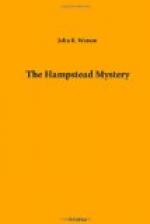“Yes, sir.”
“Were you afraid of physical violence from him, or only that he would expose your past to the other servants?”
“I was afraid of him both ways,” said Hill.
“Was it because of this fear that you made out for him a plan of Riversbrook to assist him in the burglary?”
“Yes, sir.”
“When did you make out this plan?”
“The day after Sir Horace left for Scotland.”
“Was that on your first visit to Miss Fanning’s flat in Westminster after the prisoner had sent her to Riversbrook to tell you he wanted to see you?”
“Yes, sir.”
“Did Birchill stand over you while you made out this plan?”
“Yes, sir.”
“Would you know the plan again if you saw it?”
“Yes, sir.”
Mr. Finnis, who had been hiding the plan under the papers before him, handed a document up to his chief.
Mr. Holymead unfolded it, and with a brief glance at it handed it up to the witness.
“Is that the plan?” he asked.
Hill was somewhat taken aback at the production of the plan. It was drawn in ink on a white sheet of paper of foolscap size, with a slightly bluish tint. The paper was by no means clean, for Birchill had carried it about in his pocket. The witness reluctantly admitted that the plan was the one he had given to Birchill. To his manifest relief Counsel asked no further questions about it. In a low tone Mr. Holymead formally expressed his intention to put the plan in as evidence. He handed it to Mr. Walters, who, after a close inspection of it, passed it along to the judge’s Associate for His Honour’s inspection.
The rest of Hill’s cross-examination concerned what happened at the flat on the night of the burglary. He adhered to the story he had told, and could not be shaken in the main points of it. But Mr. Holymead made some effective use of the discrepancy between the witness’s evidence at the inquest as to his movements on the night of the murder and his evidence in court. He elicited the fact that the police had discovered his evidence at the inquest was false and had forced him to make a confession by threatening to arrest him for the murder.
Mr. Holymead signified that he had nothing further to ask the witness, and Mr. Walters called his last witness, a young man named Charles Ryder, a resident of Liverpool, who had spent a week’s holiday in London from the 14th to the 21st of August. Ryder had stayed with some friends at Hampstead, and when making his way home on the night of the 18th of August had walked down Tanton Gardens in the belief that he was taking a short cut. The time was about 11.20. He saw a man running towards him along the footpath from the direction of Riversbrook. He caught a good glimpse of the man, who seemed to be very excited. He was sure the prisoner was the man he had seen. In cross-examination by Mr. Holymead he was far less positive in his identification of the prisoner, and finally admitted that the man he saw that night might be somebody else who resembled the prisoner in build.




